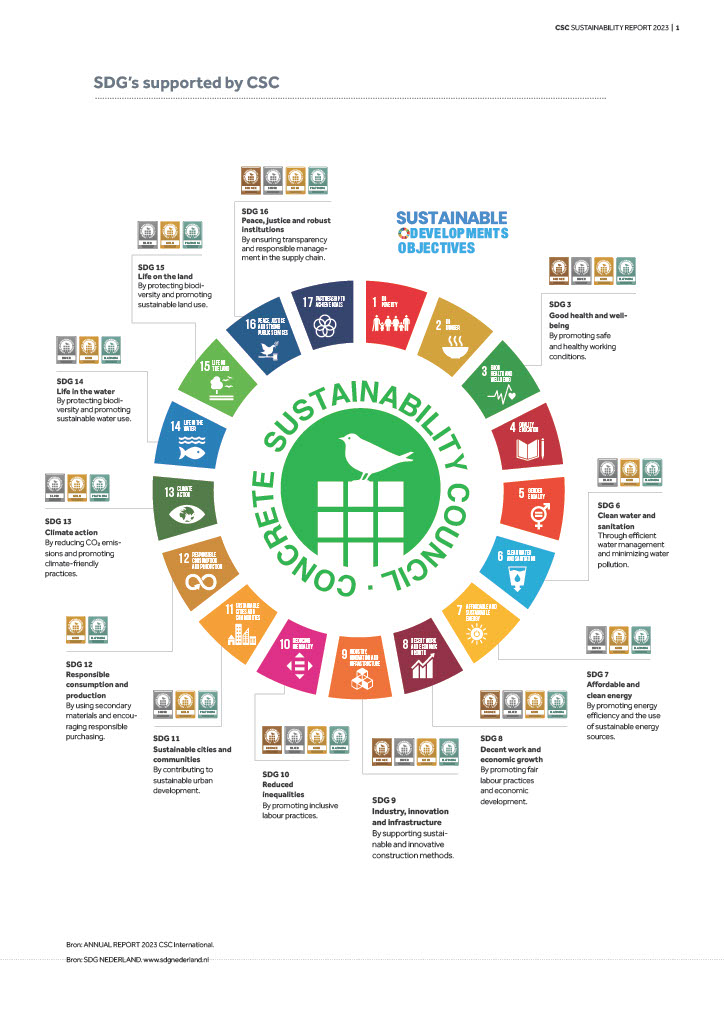
CSC Standards
Picture: GCCA Picture competition 2024/2025 Jason Balaba Futuristic Ithra Library, Dharhran, Saudi Arabi. The futuristic design of Ithra Library is inspired by natural, organic shapes, and the building as a whole feels like it is in constant transformation, symbolizing progress and cultural growth.
CSC Standards
We undertake monitoring, verification or assurance of our standard, performance levels, or improvement pathways and we make an overview of our approach publicly available
Our Voluntary Standard, Performance Levels, and Improvement Pathways
At CSC, we have developed a voluntary standard that is publicly available and designed to drive sustainability across the concrete, cement, and aggregate industries. Our standard is built on the 10 ISEAL Credibility Principles and provides a clear framework with defined performance levels and improvement pathways, including specific KPIs and targets that address a wide range of sustainability topics.
Background and Rationale
Following the adoption of the United Nations Sustainable Development Goals (SDGs) in 2015, the CSC was founded in 2016 under the World Business Council for Sustainable Development (WBCSD). The concrete industry—responsible for producing 14 billion m³ globally in 2020—was recognized for its enormous potential to contribute to sustainable, resilient infrastructure. However, the industry also faces significant environmental and social challenges, including CO₂ emissions, resource extraction, and labor practices.
To address these dual realities, CSC launched its Certification System in 2017, providing a robust, transparent, and credible mechanism to transform sustainability from exception to norm within the sector. Inspired by systems like the FSC and Aluminium Stewardship Initiative (ASI), the CSC combines performance-based certification with market incentives, assurance mechanisms, and global alignment.
Key Components of Our Standard:
1. Comprehensive Sustainability Coverage:
Our standard takes a holistic approach, addressing the environmental, social, and governance (ESG) dimensions of sustainability. It sets transparent performance benchmarks across critical areas, including:
Water stewardship and responsible resource management
Energy efficiency and greenhouse gas (GHG) emissions reduction
Ethical business conduct, human rights protection, and anti-corruption measures
Supply chain traceability and responsible sourcing practices
Innovation and continuous improvement to foster long-term sustainability
Circularity, innovation, and continuous improvement
By aligning with global sustainability goals, our framework ensures that certified companies meet and exceed industry best practices.
2. Defined KPIs and Targets:
We outline specific, measurable KPIs and targets within our standard. For example, our criteria include:
Water Management (SDG 6): Policies and targets for optimizing water use and ensuring water quality. The CSC certification plays a vital role in advancing Sustainable Development Goal 6 by actively contributing to responsible water management practices within the cement industry. Through its rigorous standards, CSC ensures that companies adopt measures to optimize water use and safeguard water quality. This includes implementing policies to use water responsibly and conducting assessments to address water scarcity concerns in the plant area. Moreover, CSC-certified companies are committed to monitoring and reporting their water consumption, as well as implementing appropriate measures to process returned concrete, thus minimizing water wastage. By adhering to the E5 criteria of the CSC certification, companies not only strive towards achieving water efficiency but also contribute to the conservation and sustainable management of water resources, ultimately supporting the goal of ensuring availability and sustainable management of water and sanitation for all.
Energy and Climate (SDG 7 & 13): Guidelines to reduce CO₂ emissions, promote energy-saving practices, and encourage the use of renewable energy. The CSC certification advances Sustainable Development Goals 7 and 13 by promoting energy efficiency and reducing CO2 emissions in the cement industry. Through its E3 criteria, CSC ensures companies adopt sustainable transport management, implement climate policies (E3.01), monitor and publicly report GHG emissions (E3.02, E3.03), and undergo external verification (E3.04) to enhance transparency. It also encourages science-based CO2 reduction targets (E3.07, E3.08), energy-saving awareness (E3.09), and the use of renewable energy (E3.11). By fostering accountability and sustainability, CSC certification drives responsible energy use and climate action, supporting global efforts to mitigate climate change.
Responsible Production (SDG 12): Flexible certification scopes that allow plants to progressively achieve higher performance levels, thereby incentivizing sustainable practices across the supply chain. The CSC certification system plays a crucial role in advancing Sustainable Development Goal 12 by promoting responsible consumption and production practices within the construction industry. One of the key ways it contributes is through its flexible approach to certification scope. While the emphasis is primarily on the concrete sector and its supply chain, CSC allows individual concrete plants to achieve certification up to the Level Silver even if their suppliers, such as cement and aggregate providers, are not yet certified. This flexibility incentivizes suppliers to adopt sustainable practices to meet CSC standards, thereby promoting responsible production throughout the supply chain. Furthermore, CSC recognizes certificates of responsible sourcing systems for steel production, which expands the reach of sustainable practices beyond concrete to other essential construction materials. By advocating for the adoption of CSC certification across the construction value chain, including stakeholders beyond the concrete sector, CSC drives the adoption of sustainable practices and fosters a culture of responsible consumption and production, in line with the objectives of SDG 12.
Social and Governance Aspects (SDG 10 & 16): Requirements for ethical conduct, human rights adherence, and anti-corruption measures. CSC certification significantly contributes to Sustainable Development Goals 10 and 16 by promoting fair business practices, ethical conduct, and compliance with legal and human rights standards within the cement industry. Its robust framework ensures adherence to all applicable legislation (P1.01) and enforces a zero-tolerance policy towards corruption (P1.02). Additionally, CSC-certified operations commit to upholding internationally recognized human rights (P2 criteria), including labor rights (P2.03), and respect for indigenous peoples’ rights (P3 criteria), ensuring their free, prior, and informed consent (P3.02). By fostering accountability, transparency, and social inclusion, CSC certification helps reduce inequalities (SDG 10) and strengthens the rule of law while combating corruption (SDG 16), thereby advancing sustainable development globally.
These indicators drive continuous progress, enabling companies to track, measure, and improve their sustainability performance over time. They are also aligned with CSC’s Theory of Change, which envisions concrete as the sustainable, low-carbon, circular, and resilient construction material globally—making a meaningful contribution to climate goals, biodiversity protection, and the achievement of the SDGs.
3. Public Accessibility and Transparency:
Transparency is a cornerstone of our approach. Our entire standard, technical manuals, and supporting documentation are available on our website (www.csc.eco), ensuring that:
Stakeholders, industry participants, and the public can access our sustainability framework and performance criteria.
Companies seeking certification understand the requirements and improvement pathways to achieve higher levels of sustainability.
This commitment to public access and stakeholder engagement fosters trust and industry-wide adoption.
4. Dynamic Improvement Pathways for Continuous Progress
Sustainability is an evolving challenge. To ensure our standard remains responsive to emerging industry needs, we implement a continuous improvement process:
Regular updates based on stakeholder feedback and industry best practices.
Independent audits and annual reporting to assess effectiveness and identify opportunities for refinement.
Flexibility for companies to set progressive targets, allowing them to advance from compliance to leadership in sustainability
A performance ladder of Bronze, Silver, Gold, and Platinum levels, incentivizing continuous progress
This adaptive approach ensures that CSC-certified companies are not only meeting today’s sustainability benchmarks but also driving future innovations in responsible sourcing and production.
CSC’s modular approach—including the R-Module (recycled materials) and CO₂-Module (emissions performance)—provides targeted pathways for innovation, circularity, and climate action.
5. Alignment with Global Sustainability Objectives
Our standard directly contributes to international sustainability frameworks, reinforcing the role of the concrete industry in achieving global climate and development goals.
We support and contribute to:
UN Sustainable Development Goals (SDGs) by promoting water efficiency, energy conservation, emissions reduction, and social responsibility.
Science-Based Targets initiative (SBTi) by encouraging companies in setting and achieving climate-aligned emissions reductions.
The EU Taxonomy for Sustainable Activities, by fostering compliance with emerging green finance and ESG reporting requirements.
By embedding ambitious but achievable sustainability targets, CSC empowers companies to make measurable contributions to global sustainability efforts while strengthening their long-term business resilience.
Conclusion
Through our publicly available, voluntary standard, CSC provides a rigorous, transparent, and continuously progressing sustainability framework. By defining clear performance levels, improvement pathways, and measurable KPIs, we enable companies to:
Assess and improve their sustainability performance in a structured manner.
Demonstrate leadership in responsible sourcing and production.
Meet investor, procurement, and societal expectations
Contribute to global efforts to decarbonize the built environment.
This comprehensive, impact-driven approach ensures that CSC-certified operations are not only compliant with industry best practices but also at the forefront of sustainable innovation.
